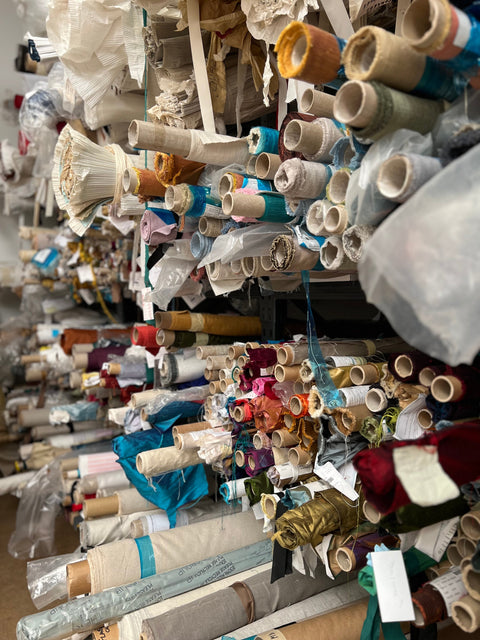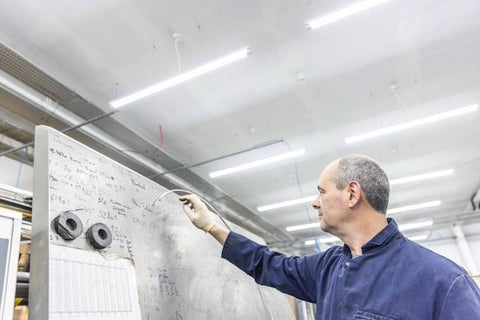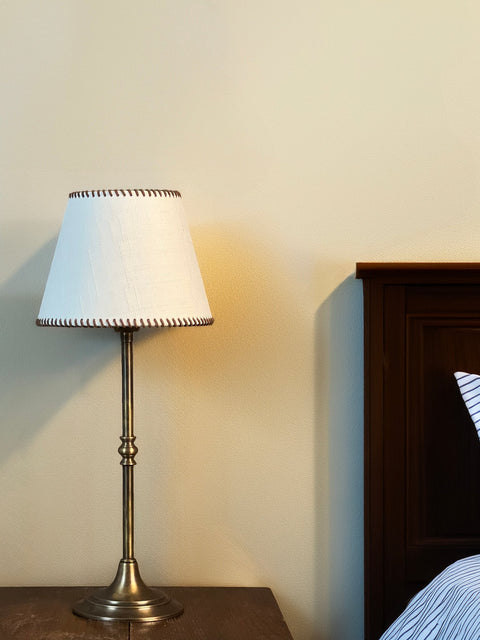Lampshades can come in a variety of textures and styles, and each one paints a differently unique picture for your interior design. Alongside factors like durability, light diffusion, cost, and ease of use, it can be tricky to pin down the one you like the most. But don’t worry if you’re stuck between choices - this guide is here to break down some of the fabrics and textures that we can offer for your bespoke shade, and help you on your way to your dream design!
Cotton
Cotton is a natural fabric and a popular choice for lampshade design. It is durable and easy to clean, as well as being reasonably versatile when it comes to colours and patterns to choose from. Cotton is lightweight and breathable, allowing it a more casual, relaxed air when chosen as a lampshade fabric - but this casual look may appear less refined in formal interiors, which is something to consider. Cotton may also ‘yellow’ or fade over time with prolonged exposure to heat or sunlight.
Pros:
-
Lightweight and breathable
-
Versatile and widely available
-
Takes colour and print well
-
Easier to clean
Cons:
-
Can sometimes lack refinement in formal interiors
-
Prone to ‘yellowing’ or fading in direct heat/sunlight
-
Slightly less durable than heavier weaves

[Pictured: our Pear Wavy Coolie Table Lamp by Iberian Lighting x Ashdown Pottery]
Linen
Linen is another natural fabric that has a rustic, laidback feel to it. It offers a textured look that fits nicely within organic or rustic spaces, as it lends a very natural feeling. It is more durable than cotton, but can be more expensive to obtain - nonetheless it ages incredibly beautifully and can be considered an investment or a value for money. Linen gives off a warm, gentle diffusion of light, making it another popular choice in interior design and an excellent choice for lampshades that want to exude a warm, inviting aura.
Pros:
-
Natural, textured appearance
-
Stronger than cotton so more durable
-
Offers a gentle light diffusion that adds warmth
Cons:
-
Can be prone to wrinkling easily
-
May be more expensive than cotton
-
Can appear more ‘informal’ in some luxury settings

[Pictured: our Three Tier Kidney Beige Linen Lampshade]
Silk
Silk exudes luxury and refinement, making it ideal for classic and elegant interiors. When chosen for a lampshade fabric it provides an inviting warmth through its light diffusion, which is perfect if you’re searching for that pop of elegance in your space. Silk shades have a beautiful shine and eye-catching texture to them that will draw focus without a doubt. With this in mind, silk is typically more expensive than more natural fabrics and is especially more delicate, prone to damage from heat and moisture which may result in the need for specialist cleaning and regular upkeep.
Pros:
-
Luxurious finish and texture, perfect for classical or elegant designs
-
Softens and diffuses light in a flattering way
-
Large selection of eye-catching colours and patterns
Cons:
-
Delicate, which requires careful attention and perhaps specialist upkeep
-
Typically more on the expensive side

[Pictured: our Box Pleat Silk Lampshade]
Velvet
Velvet shades have a rich and tactile texture, one that is striking to all of the senses. It is noted to be an opaque fabric for shades, resulting in a thicker, heavier lampshade that blocks and shapes the light dramatically - perfect for those moody interiors! Velvet is soft and plush, available in a range of colours and styles, but it should be remembered that they do require regular maintenance as they can absorb dust quicker than other fabrics.
Pros:
-
Rich, tactile texture – makes a statement even when the light is off
-
Excellent for creating mood lighting
-
Blocks and shapes light dramatically, ideal for accent lighting
Cons:
-
Heavy and can trap heat
-
Absorbs dust and may require regular maintenance
-
Can be overpowering in small spaces if used too heavily

Card/paper/parchment
Often seen in mid-century or Japanese-inspired interiors, lampshades made of card, paper, or parchment give a crisp and minimalistic aesthetic to your interior design. They work well for ambient lighting as they give off a calm and warm aesthetic, leaning more towards the translucent side of fabric in a way that blends the light into a soft glow. However, due to their delicate nature they can be sensitive to moisture, heat, and wear over time.
Pros:
-
Lightweight and affordable
-
Crisp and minimalistic
-
Provides soft light diffusion
Cons:
-
More delicate than most fabrics - sensitive to moisture and tearing
-
Not suitable for high-heat lamps
-
Better suited for decorative lamps rather than anything high-usage

[Pictured: example of a card shade from our upcoming range]
Printed textiles
Printed textile lampshades are the perfect way to imbue your interior design with a personal touch. At Iberian Lighting we offer bespoke printing services for your lampshades, meaning that you can discuss any pattern or print that you have in mind and our expert team will work closely with you as we work to transform it into the lampshade of your dreams! Printed shades are a perfect focal point for a room, easily tying together a room’s colour palette or thematic style. While they offer limitless creative potential, it is worth noting that the prints may fade over time with direct sun exposure and may be less adaptable to a room in which the décor style changes frequently.
Pros:
-
Adds personality and pattern – great for custom or statement pieces
-
Works well with cotton or linen bases
-
Can tie into room colour schemes or themes
Cons:
-
Print may fade over time if exposed to direct sunlight
-
Busy patterns can limit flexibility with décor changes
-
Needs careful pattern placement to look balanced on the frame

[Pictured: a bespoke shade in printed House of Hackney fabric]
Opaque vs translucent
Opaque fabrics, such as velvet or blackout-lined shades, block the light from passing through the sides of the shade. Instead, the light is directed above and below, which creates focused, directional lighting. These are perfect for spaces which are designed for more compact or controlled light flow, such as a cosy reading nook.
Translucent fabrics, such as cotton, linen, and even some silks, allow the light to pass through the sides of the shade. This creates a warm and soft effect with the light output, highlighting textures and offering an ambient glow. These shades are perfect for living rooms and bedrooms, or anywhere that requires an aura of warmth and comfort.


If you want to browse our fabric range, check out our bespoke order fabric guide here.
For a more in-depth chat about our fabric choices, or if you have questions about a fabric that isn’t in the guide, get in contact with our expert team today!










Comments (0)
There are no comments for this article. Be the first one to leave a message!